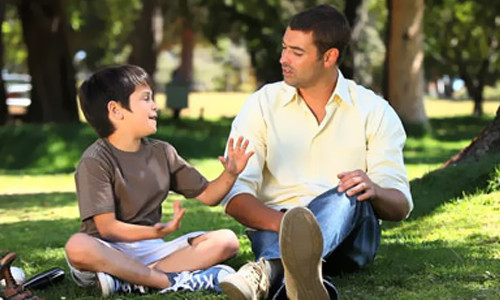
Hey there! How is your holiday season going so far?
We’re closing in on the end of Hanukkah, and zero-minus-three days until Christmas. So, if you’re finding there’s a wee bit more friction with your middle schooler than you’d like, read on.
I’ve got some gifts in my bag (or the rest of this post).
The holidays are billed as the “most wonderful time of the year,” but for parents of middle schoolers, they can feel more like a high-stakes emotional obstacle course. Between the overstimulating family gatherings, disrupted routines, and the sudden appearance of “The Tone” at the dinner table, the festive spirit can evaporate faster than a tray of sugar cookies or your unsavory grand-uncle’s bottle of Jim Beam.
If you feel like your once-sweet child has been replaced by a surly stranger this December, you aren’t alone—and you aren’t failing. You’re just dealing with a new developmental stage that requires a new set of tools.
Enter a few Parenting Genius moves: ways to navigate these years - or just this season - by shifting from reacting to responding.
Step 1: The Power of Decoding
The most important skill to master this season is Decoding. This is the ability to look past a frustrating behavior to identify the actual need driving it. Instead of asking, “How do I win this moment?” or “Why are they being so difficult?” Decoding asks: “What does my child need right now?”
When we decode accurately, our children don’t have to “shout” their needs through defiance or withdrawal.
1. The Holiday “Hider” (Withdrawal)
- The Scene: You arrive at Grandma’s house, and your tween immediately disappears into a guest room with their phone.
- The Misinterpretation: “They are being rude and shutting out the family.”
- The Decode: Space. Middle schoolers are socially exhausted. Their brains are “on stage” all day. The holidays increase this pressure tenfold.
- The Parenting Genius Move: Set boundaries (with love) + Run Cover. Establish your expectations regarding your child’s family engagement. Acknowledge their need for a little space. Then, protect their space for 20 minutes so they can recover. Connection comes after regulation, not before. Welcome them back when they are ready with open arms.
2. The Festive “Hoverer” (Clinginess)
- The Scene: Your usually independent 13-year-old won’t leave your side at the company party.
- The Misinterpretation: “They’re regressing. They need to just go talk to people.”
- The Decode: Safety. Large crowds or unfamiliar social dynamics can make a tween feel exposed.
- The Parenting Genius Move: Be the solid base. Let them stay near you until they feel regulated. Confidence grows from safety—not force.
3. The Yuletide “Snark” (Defiance)
- The Scene: You ask them to put on a nice sweater, and they respond with a sharp, “I KNOW, MOM. GOD.”
- The Misinterpretation: “They are being disrespectful and ungrateful.”
- The Decode: Autonomy. Their sense of self feels fragile. When we dictate small things, their “identity alarm” goes off.
- The Parenting Genius Move: Lower the control, increase the respect signals. Tone softens when kids feel trusted.
Why the “Old Moves” Fail During the Holidays
Many of us fall into “Outdated Parenting”—using strategies that worked when our kids were six but backfire now that they are twelve. During the high-pressure holiday season, these five mistakes are especially common:
- Over-Explaining (The Holiday TED Talk, or as David Yeager calls it “grownsplaining”): When we lecture for five minutes on the “true meaning of Christmas” after a minor infraction, tweens glaze over. The Fix: Say less. Shorter responses communicate: “I trust you can handle this.”
- Correcting in Public: Calling out their manners or behavior in front of the whole family feels like a social “threat” to a middle school brain. The Fix: Protect their dignity. Teach the lesson later, in private.
- Matching Their Energy: They snap, so you snap. Now you have two activated nervous systems and a ruined dinner. The Fix: Stay grounded. Your calm is your power.
- Taking it Personally: When they roll their eyes, it feels like a rejection of you. The Fix: Separate the behavior from your history. Not everything is about you—even when it hurts.
- The Rescue Reflex: Stepping in to solve every conflict with a cousin or sibling. The Fix: Support without stealing the struggle. They need to build the “muscle” of solving their own problems.
The Season for Skillful Restraint
The holidays reduce our patience and raise our expectations, creating a perfect storm for conflict.
But remember: this is not the season for perfection.
It is the season for skillful restraint.
By decoding the “why” behind the behavior and updating your parenting moves, you aren’t just surviving the holidays—you’re learning the language of a whole new, exciting, and profoundly beautiful stage of your child’s life.
You’re not behind. You’re becoming a Parenting Genius.
Happy Holidays!
© 2025 Parenting Genius. All Rights Reserved

Unlock the magic of middle school this holiday season by gifting your child the powerful tools of self-discovery and reflection. As middle schoolers embark on the critical journey of shaping their own identities, parents have the unique opportunity to become supportive guides in this transformative process. This post offers actionable strategies, from “Highs and Lows” conversations to creative expression projects that help kids explore who they are in a fun and engaging way. Encouraging your child to reflect, understand their strengths, and embrace the complexity of early adolescence can be a truly enlightening experience. Discover practical ways to connect with your child and witness the everyday magic of them becoming themselves. Embrace the joy of middle school parenting and make this season one of connection and growth for both you and your middle schooler!
Read more...
The world lost a remarkable human yesterday. Dr. Jane Goodall, the pioneering primatologist who spent decades sitting patiently in the forests of Gombe, passed away at 91, leaving behind a legacy that extends far beyond her revolutionary discoveries about chimpanzee behavior. While we celebrate her contributions to conservation and our understanding of our closest evolutionary relatives, parents have reason to pay particular attention to another dimension of her brilliance: what she observed about raising young — both chimp and human. Dr. Goodall was particularly interested in chimpanzee rearing practices and documented them meticulously throughout her decades of research. Her landmark studies at Gombe transformed scientific understanding of chimp mother-infant-child bonds and family dynamics.
Here's the wonderful irony: While many parenting experts have built careers on theories spun from conference rooms and clinical observations, Goodall learned some of parenting's most profound truths by watching chimpanzee mothers in the wild. And about those observations? They align beautifully with the Parenting Genius method — the 10 essential skills that transform how we guide our adolescents through the turbulent, hilarious, occasionally hair-raising journey to adulthood.
What a Woman Who Lived with Chimps Can Teach Us About Raising our Tweens & Teens.
Let's be clear: Your tween/teen is not a chimpanzee (though on certain Monday mornings, you might wonder.) But Goodall understood something fundamental — that the behaviors and needs of young primates share striking similarities to the needs of human adolescents, whether they're swinging through trees or scrolling through TikTok. She watched chimp mothers navigate the same challenges human parents face: How much protection is too much? How do you build trust? When do you let go?
Her answer, refined through thousands of hours of observation and applied to raising her own son, Grub, provides a masterclass in the 10 core competencies of Parenting Genius (plus the Bonus!).
10 Skills to Parenting Genius: Goodall's Wild Validation
1. Emotional Attunement
Goodall discovered that the most successful chimp mothers possessed an almost supernatural ability to read their infants' emotional states. They knew when their young needed comfort versus when they needed space. Sound familiar? This is emotional attunement—the capacity to tune into your adolescent's emotional frequency even when they're broadcasting on static. When your 13-year-old says "I'm fine" in that particular tone, you know they're anything but. That's Goodall-level observation at work.
2. Active Listening
In the forest, Goodall didn't just watch chimps; she listened — to their vocalizations, their silences, the rustle of leaves that signaled their movements. She understood that communication is multidimensional. Similarly, active listening with adolescents means hearing not just their words but the emotions underneath, the body language, the things they're not saying when they slam that door. It's listening with your full attention, even when they're explaining Minecraft drama for the 47th time.
the rustle of leaves that signaled their movements. She understood that communication is multidimensional. Similarly, active listening with adolescents means hearing not just their words but the emotions underneath, the body language, the things they're not saying when they slam that door. It's listening with your full attention, even when they're explaining Minecraft drama for the 47th time.
 the rustle of leaves that signaled their movements. She understood that communication is multidimensional. Similarly, active listening with adolescents means hearing not just their words but the emotions underneath, the body language, the things they're not saying when they slam that door. It's listening with your full attention, even when they're explaining Minecraft drama for the 47th time.
the rustle of leaves that signaled their movements. She understood that communication is multidimensional. Similarly, active listening with adolescents means hearing not just their words but the emotions underneath, the body language, the things they're not saying when they slam that door. It's listening with your full attention, even when they're explaining Minecraft drama for the 47th time.3. Companioning
Here's where Goodall's work becomes almost poetic. She observed that chimp mothers didn't just supervise and teach their young — they accompanied them. They were present, moving through the forest alongside their adolescents, available but not plowing or hovering. This is companioning: being a steady, reliable, positive presence in your adolescent's life without trying to control or direct every moment. You're the experienced traveler walking beside them on their journey, not the plow removing hurdles or a helicopter circling overhead ready to swoop in at any moment.
4. Repairing
Goodall documented something revolutionary: even the best chimp mothers made mistakes. They got frustrated. They occasionally misjudged situations. But the successful ones had a remarkable ability to repair those ruptures— to reach out, reconnect, and restore trust with their young, and with other himchimp adults.
"They’re very good at reconciliation after conflict. We don’t seem to be very good at that. We hold grudges. We fight wars. We have conflict all over the world today. So, if we were a little bit better just making things up without continuing to fight about them or hold grudges."
Your adolescent doesn't need perfect parenting; they need a parent who can admit "I messed that up" and work to make it right. That's repairing, and it's pure Goodall wisdom.
5. Decoding Behavior
This was Goodall's genius: She looked at behavior not as random or defiant, but as communication. When a young chimp acted out, she asked: What need is driving this? Are they hungry, scared, seeking status, craving connection? Human aolescent behavior works the same way. That eye-roll isn't just teenage attitude—it might be exhaustion, overwhelm, or a clumsy attempt to assert independence. When you can decode behavior to understand the underlying need, knowing how to respond effectively becomes much easier.
6. Boundary Setting and Holding
Don't let Goodall's gentle demeanor fool you—she observed that effective chimp mothers set clear boundaries and held them. Young chimps who were allowed to do anything, anywhere, anytime? They struggled. Those with firm, consistent limits? They thrived. Our human adolescents are no different. They're testing boundaries not because they want them removed (despite the thunderous sigh when you make them put their phone away at 10PM), but because they need to know they're solid. A tweens search for boundaries can seem clumsy - they push until they bump up against them. And when they do, they have clarity and a sense of safety. Boundaries are love made visible.
7. Giving Feedback / Reflecting Back
Goodall noticed that chimp mothers provided constant, gentle feedback to their young through gestures, vocalizations, and demonstrations. They showed their infants what worked and what didn't, acting as mirrors. Effective parenting of adolescents requires the same skill: reflecting back what you observe without judgment. "I noticed you seemed stressed when you talked about the math test" creates space and information that builds self-awareness, which contributes to identity development. When you notice that something is particularly easy for them, or they seem to really enjoy something, tell them! They uncover who they are, in part, by what you tell them. It's observation as gift.
8. Motivation
Here's a surprise: Goodall found that chimp mothers motivated not through force but through encouragement, modeling, and reassurance. They made activities look engaging; they celebrated small victories; they created conditions where their young wanted to try new things. Our adolescents respond well to the same approach. Intrinsic motivation—the kind that comes from within and lasts — comes from connection, autonomy, and seeing possibilities, not from threats about their permanent record. And the highest motivations come when parents communicate high standards, a strong belief in a child's ability, and the support to achieve the goal at hand.
9. Self-Knowledge
Goodall spent years observing not just chimps but her own reactions, biases, and triggers. She understood that to be effective in her work, she needed deep self-awareness. The same applies to parenting your adolescents. Your teenager's behavior will activate your own childhood wounds, insecurities, and fears. Self-knowledge means recognizing your triggers, when you're reacting from your own stuff rather than responding to what your child actually needs. It's hard work. Goodall would approve.
10. Self-Regulation
In the forest, Goodall remained calm in situations that would terrify most people—charging chimps, territorial disputes, unpredictable wildlife. She regulated her own emotional responses to stay present and observant. Parenting adolescents requires the same superpower. When your teenager pushes every button you have (and some you didn't know existed), self-regulation allows you to respond rather than react. It's the ability to be the calm in their storm.
BONUS! Building and Nurturing an Adult Ecosystem of Support
Perhaps Goodall's most profound observation was this: Successful chimp mothers didn't raise their young in isolation. She observed female chimpanzees offer each other support while raising their young, and documented instances of mothers receiving attentive care for her offspring but other femal chimps. Not only was the mother chimp supported by a community of her peers, young chimps were surrounded by a community too —aunties, older siblings, tolerant males, peers. They learned from multiple adults, creating resilience and diverse perspectives.
You need an ecosystem of support to be a successful parent - no matter how you define success. You simply can't - and should not - do this alone. Create a group or join an existing pod, and make sure you've got easy access to experts and specialists. It'll keep your worry in check, your sense of humor high, your sanity in tact, and your kids on a positive path. This is a long journey.
Build that pod you can lean on. Goodall showed us why it matters.
From Gombe to Your Living Room
The beautiful thing about Goodall's legacy is its accessibility. All she needed was some critical questions, a few key skills, patience, curiosity, a willingness to observe deeply and accept the truthes that were revealed. The same tools that helped her revolutionize primatology can transform your parenting.
Learn what to focus on, gain a few key age-spefic skills, and watch your adolescent the way Goodall watched her chimps:
With curiosity, not judgment.
With patience, not frustration.
With the understanding that behavior is communication, that development takes time, and that your presence matters more than your perfection.
Goodall once said that what you do makes a difference, and you have to decide what kind of difference you want to make.
In parenting, that difference starts with these 11 skills— with seeing your adolescent clearly, meeting them where they are, and guiding them with the wisdom that comes from deep observation and deeper love.
A Fitting Farewell
As we bid farewell to Dr. Jane Goodall, we celebrate not just her scientific achievements but her gift for paying attention—to chimps, to patterns, to the fundamental needs that connect all young beings. She spent her life showing us that when we observe with care and respond with wisdom, we unlock potential we didn't know existed.
Your adolescent doesn't need you to be Jane Goodall. But they do need you to bring some of her spirit into your parenting: the curiosity, the patience, the willingness to learn, grow, and see behavior as information rather than defiance. They need you to master these 11 skills not perfectly, but persistently.
And maybe, just maybe, when parenting feels impossible—when you're certain you're failing at this whole raising-humans thing—you can remember the woman who sat in the African forest, watching chimps with extraordinary patience, and discovered that the answers were there all along. Waiting to be observed. Waiting to be applied. Waiting to change everything.
Thank you, Dr. Goodall. For the chimps, for the planet, and for showing parents everywhere what becomes possible when we truly pay attention.
Rest well in the forest of eternal wisdom. Your legacy lives on in every parent who chooses connection over control, observation over assumption, and love over fear.
© 2025 Parenting Genius. All Rights Reserved

Embarking on the turbulent yet wildly entertaining journey of parenting a middle schooler is like being handed a front-row ticket to a live comedy show where the script is a constant work in progress. Amidst the chaotic demolition and rebuilding of your tween's brain, you'll witness hilariously questionable fashion choices and social dynamics that could rival a Shakespearean drama. While your child's quest for independence may transform you from cherished companion to "embarrassing entity," don't let the awkwardness get the best of you. Embrace the absurdity and marvel at the magnificent metamorphosis as your child tests new identities like outfits from a discount store. Through the trials of peer pressure and the evolving need for respect, your evolving role as a supportive companion becomes paramount. So, grab that popcorn and buckle up for a sidesplitting, heartfelt ride—because these are the years you won't just survive but will find surprisingly hilarious and rewarding in ways you never expected.
Read more...








